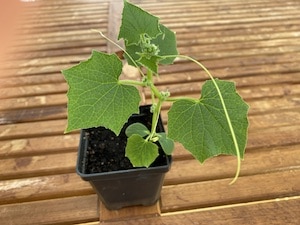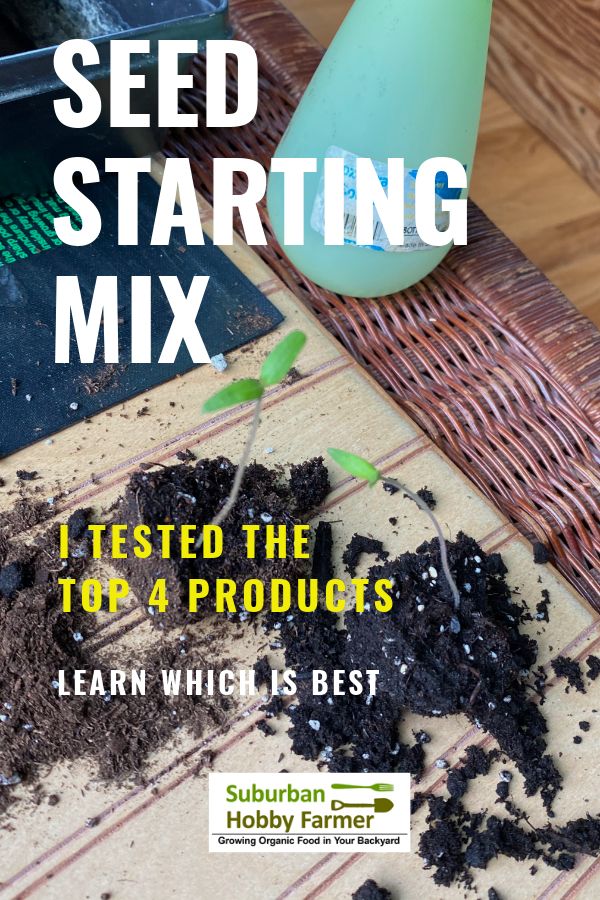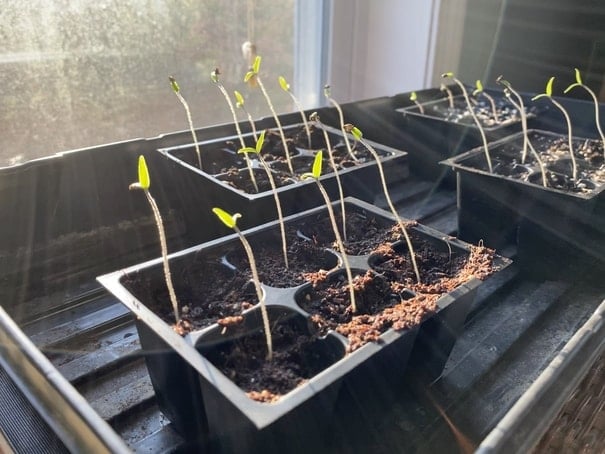Updated: December 1, 2023
I used to make my own seed starting mix. No more! Don’t get me wrong. Seed starting soil is very important to the success of your seedlings. It’s important enough that you might want to completely control the process and make your own.
One year I bought a bad batch of mix, and my seedlings turned out awful. In fact, they were so bad that I couldn’t use them and ended up buying seedlings from a nursery.
Still, mix is so inexpensive, easy and fast to buy online, it doesn’t really make sense to mix your own anymore. It’s cheaper and also better to have the professionals make it, rather than buy the ingredients in bulk and do it yourself.
So, to help make sure you don’t get a bad product (as I did), I’ve conducted an unbiased test of the four top seed starting mixes. Here’s what I learned:
Let’s take a sec to get the legal words out of the way. This article may contain affiliate links. That means if you click and buy from my partners, I will make a tiny amount of money at no cost to you. This in no way affects my recommendations.
Table of Content
This is a long, detailed article. You can jump to where you want to be by clicking on the different sections below. To come back to this table of contents, just use the back button on your browser.
The Best Seed Starting Mix …
If you don’t want all the details and just want to know which one is best, it’s Burpee Organic Seed Starting Mix!
All the seeds planted in Burpee sprouted as fast or faster than the others, and the seedlings were more vigorous than the others.
However, Burpee did not perform well when using a soil block maker. The mix did not hold together well enough for blocks.
If you are going to make soil blocks, the best product is the Promix. It held together very well and was almost as good as the Burpee mix in my test.
Now that the secret is blown, read on to learn about the details.
Test Criteria
I conducted the test by looking at the top four OMRI listed organic products:
- Burpee Seed Starting Mix
- Black Gold Seedling Mix
- Sprout Island Blend Organic Seed Starter
- Promix Organic Pro Seed Starting Mix
Why OMRI listed products only? OMRI (Organic Materials Review Institute) reviews products to make sure they are acceptable for certified organic production. I only use organic seed starting mix for my seedlings.
I can see how some people could disagree with this criteria. After all, seed starting soil ingredients probably are pretty clean.
But I want my food to be the very best, healthiest food possible. So OMRI listing is worth it to me.
I also decided to exclude products with vermiculate. Why? For two reasons:
- Not all but some sources of vermiculate have been found to contain asbestos. No thank you!
- Breathing in vermiculate makes me cough. I know this from working with it in the past.
No worries! In just about all cases, perlite is a good substitute for vermiculate.
Also, the manufacturers have included organic fertilizer in each of the products. While fertilizer may increase the chances of dampening off, I believe a little fertilizer helps the seedlings to have nutrients as soon as they need it. They shouldn’t have to wait for the grower to add liquid fertilizer.
Most importantly, I tested the following criteria for each of the organic seed starting mixes:
- When plants poked above the soil
- Which plants were most vigorous
- Which showed signs of dampening off
Finally, I think you should know that the products looked significantly different right out of the bag. They obviously are not all the same.
This was surprising to me because I expected a standard recipe for seed starting soil. Obviously, the experts differ on what works best.

Burpee Organic Seed Starting Mix
Manufacturer: Burpee
Ingredients:
- Primarily coir (coconut fiber)
- Organic plant food (No details given)
Features & Benefits:
- Formulated for neutral pH, which is ideal for most plants
- Speeds plant and root growth
- Provides improved root aeration
- Certified safe for organic gardening (OMRI-listed)
Important details: Burpee is the best performer. The seeds in this mix sprouted first and were the most vigorous. Plus, there were absolutely no signs of dampening off.
Surprisingly, this mix has a more orange color when compared to the others. I expect that this is because it’s made primarily of coir. There seems to be no perlite as part of this recipe.
Related: How to Use Chicken Manure Pellets
Unfortunately, Burpee Seed Starting Mix did not perform well when I used a soil block maker. The blocks didn’t hold together well. It was so bad that the blocks crumbled whenever I tried to move them.
If you are using a soil block maker, you should use Promix. It worked well with my soil block maker.
You can get more details, including pricing, on Burpee Mix here.
Promix Organic Pro Seed Starting Mix
Manufacturer: Premier Horticulture
Ingredients:
- Canadian sphagnum peat moss
- Coir (coconut fiber)
- Perlite
- Limestone
- Organic Fertilizer
- Mycorrhizae – PTB297 Technology
According to Premier Horticulture, mycorrhizae helps you in two ways. It:
- Prevents diseases (such as dampening off)
- Helps break down the organic fertilizer so the plants can use it sooner
Features & Benefits:
- Stimulate vigorous growth, strengthen roots, improve stress resistance and resist transplant shock
- Manages moisture levels and protects against root rot
- Feeds plants gradually for up to three months
- Certified safe for organic gardening (OMRI-listed)
Important details: This mix was the second best performer. It came very close to the Burpee.
Related: What are the Best Potting Benches for Vegetable Gardeners | If you repot plants often or use a soil block maker, you probably are going to need a potting bench.
The seeds in this soil sprouted immediately after the Burpee mix. Plus, the plants were almost as vigorous as the top performer. There were absolutely no signs of dampening off.
Soil blocks that I made with Promix held together well. I recommend this product if you are going to use a soil block maker.
You can get more details, including pricing, on Promix Mix here.

Sprout Island Blend Organic Seed Starter
Manufacturer: Cost of Maine
Ingredients:
- Blended sphagnum peat moss
- Perlite
- Nutrient starter (fertilizer) that includes mycorrhizae, kelp meal, worm castings and lobster meal
Features:
- Provides natural moisture retention and aeration
- Works well in cell packs or flats
- Creates a biologically diverse environment ideal for germinating seeds and rooting cuttings
- Certified safe for organic gardening (OMRI-listed)
Important details: Because I’m originally from the coast of Maine, and I’ve used Cost of Maine products for some time, I fully expected this mix to win. But it didn’t even come in second.
The seeds in this mix sprouted third and one seed never came up. The plants, however, were very vigorous. Still, they were somewhat behind Burpee and Promix.
You can get additional details, including pricing, on Sprout Island Blend Organic Seed Starter here.

Black Gold Seedling Mix
Manufacturer: Black Gold
Ingredients:
- 70 – 80% Canadian Sphagnum peat moss
- Perlite
- Yucca extract (organic wetting agent)
- RESiLIENCE(R) silicon dioxide (SiO2) from calcium silicate for resistance to wilting
Features:
- Retains moisture yet drains well
- Enhances growth
- Resists plant wilting
- Certified safe for organic gardening (OMRI-listed)
Important details: I found Black Gold to be the worst performer.
Like Coast of Maine, one seed didn’t sprout. Plus, the ones that did were significantly less vigorous.
There was no dampening off, but at one point, it looked like there might be some plant loss. I do not recommend this seed starting mix.
You can get more details, including pricing, on Black Gold Seedling Mix here.
Seed starting mix FAQ
I tested seed starting soil products and this is what I’ve found: Burpee Seed Starting Mix performed best if you start your seeds in pots. Promix Organic Pro Seed Starting Mix was best if you start your seeds in soil blocks.
It provides the ideal growing media for starting seeds indoors. Good seed starting mix holds moisture better than soil and usually it’s sterile, so that there are no bugs and doesn’t promote dampening off. It’s also good for starting seedlings outside, too.
Backyard gardeners can start their seedlings in pots that contain garden soil or potting soil. But they will have better results if they use seed starting mix. Often, garden soil is way too heavy for young plants and will prevent germination and root growth.
Mix is lighter than potting soil. Plus, mix is sterile to prevent bugs and dampening off of your indoor seedlings. There’s also one more big difference: potting soil usually has more nutrients and fertilizer than mix. This is because very young seedlings don’t need to get nutrients from the growing media. By having fewer nutrients, mix reduces the chance of dampening off disease in your seedlings.
Winter harvest expert Eliot Coleman, who starts a lot of vegetables, uses this mix recipe: three 8-quart buckets of peat moss, three 8-quart buckets of compost, two cups of organic fertilizer and one 8-quart bucket of perlite.
I used to mix my own seed starting mix. No more! It costs you nearly as much for the ingredients and the manufacturers have got some really good products. No sense in mixing your own anymore.
Yes, some people refer to seed starting mix as seed starting soil.
For most seedlings, perlite is just too light for starting seeds. It also doesn’t have any nutrients. Young seedlings don’t need a lot of nutrients, but as they get their second leaves, they start needing to draw nutrients from the growing media.
If you plan on growing seedlings indoors, you should use a sterile mix. First, it’s better for the mix to be sterile because you don’t want to have bugs in your house. Second, mix that isn’t sterile can promote dampening off.
OMRI-listing (Organic Materials Review Institute) indicates that the product is safe for use in organic gardening. My opinion is that you should buy OMRI-listed mix. If it’s OMRI-listed, there’s a better chance that it won’t have herbicides or pesticides in it. I believe it’s better to grow food for your table with the best possible organic ingredients.
Because you don’t have a pot to hold the mix when using soil blocks to start seeds, you must use a mix that sticks together. I’ve found that the Promix seed starting mix works well when using soil blockers. Many other mixes don’t hold together as well.
It’s not a good idea to use seed starting mixes with vermiculite. I’ve found that if you breath in vermiculite, it will cause you to cough and aggravate your breathing. Vermiculite has also been linked to asbestos because it is sometimes harvested from the same mines where asbestos is present. Of course, asbestos causes cancer. I think perlite is a good substitute for vermiculite.
In the past, seed starting mixes contained no fertilizer. This is because fertilizer is associated with dampening off in seedlings. Now it’s hard to find a seed starting mix that doesn’t have at least a little fertilizer. Providers have come to realize that it’s worth the small chance of plants developing dampening off in order to have more vigorous seedlings.
All of the following ingredients are sometimes found in seed starting mix: peat moss, coir, vermiculite, perlite, clean sand, compost, worm castings, fertilizer.
Summary
I was truly surprised by the outcome of this test. I did not expect Burpee to finish first.
But this is why unbiased testing is so important with nearly all gardening products.
Countless times I’ve purchased a plant from a nursery or seeds from a catalog or some other product, and it hasn’t performed as expected.
Anyway, I wish you good luck when starting your seeds.

Everything I Know About Starting Seeds
All my seed starting and seedling growing articles in one place.
Related articles you might enjoy:
- Build an Indoor Seedling Starting Unit
- Transplant Seedlings at Proper Soil Temperature
- Getting Rid of Gnats on Seedlings

Suburban Hobby Farmer is a participant in the Amazon Services LLC Associates Program, an affiliate advertising program designed to provide a means for sites to earn advertising fees by advertising and linking to amazon.com.

